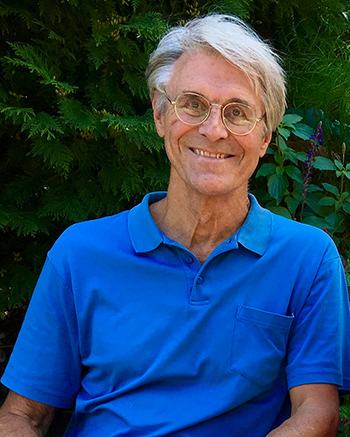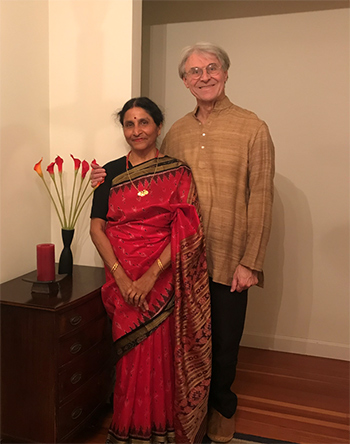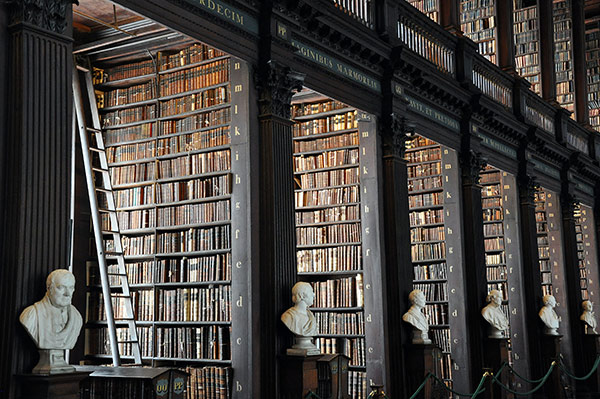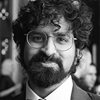Subtotal: $
Checkout
What Is Our Scholarly Inheritance?
Both the past and the future make us who we are.
By Dhananjay Jagannathan
December 31, 2022
“As are the generations of leaves, so are those of men” —Homer, Iliad vi.146
I come from an academic family. A grandfather, my mother, aunts and uncles: all scholars and teachers. As a child I took it for granted that a researcher, a scholar, and a college professor were things that I could be. I don’t take that for granted now.
My father’s sister Indira, who is an expert in the languages, literatures, and cultures of South Asia, was married to a mathematical physicist, Mark. As a child I visited Mount Holyoke, in western Massachusetts, where Indira and Mark both taught. We were living then in Jamaica and I had never seen trees that turned such brilliant colors in the fall. (It would be twenty-five years before I saw the New England fall colors in all their glory again, as I drove up to New Hampshire for my first academic job.)

Mark, 2017, photograph courtesy of Mark's mother, Jean Peterson.
But what left the most vivid impression on me as a five-year-old was the college itself. I understood that people lived and studied there, a whole community that my aunt and uncle were part of – and even my cousin Maya, who grew up on that campus and went on to become an environmental historian. In some inchoate way, I wanted to be a part of a community like that, which in time I came to think of as a kind of family, too.
Family, in the sense that encompasses all by which one generation gives life and nurture to the next, is not just a matter of biological descent. Every cultural practice – in academia, the arts, or sports – and every community centered on such a practice involves the kinship of adoption, which is as much, if not more, a matter of what we are given as what we freely and unbidden choose. In entering into such communities, we take on the obligation to pass them on faithfully, enriched by our own work.
Not long after we visited Mount Holyoke, Mark gave me a book called Game, Set, and Math by Ian Stewart, whose chapters contain a set of mathematical puzzles.
I remember spending hours with the book. My favorite chapter was called “Pascal’s Fractals,” in which Stewart describes how the self-similar patterns called fractals can be generated from sequences of numbers. An example is Sierpinski’s gasket, a fractal generated from repeatedly subdividing an equilateral triangle. It turns out that the binomial sequence, which plays an important role in algebra and in combinatorics, generates a successively closer approximation to Sierpinski’s gasket, if you represent the odd and even numbers by contrasting colors. Happily, you don’t need to know algebra or combinatorics to appreciate this phenomenon; you just need to be able to add and divide, which I could already do. I started testing out the ideas in “Pascal’s Fractals” on notepaper for myself, choosing different sets of colors. The results were beautiful. I remember thinking how amazing it was that such beauty could be out there waiting for me to find it. I started telling people I wanted to be a mathematician, like Mark, when I grew up.
I got as far as the first year of college with that dream when I realized the humanities pulled me in the most: literature and philosophy and politics. Some of the analytical rigor of mathematics was still accessible to me from within philosophy, but I didn’t want to prove theorems any more. Rather, I wanted to think carefully about the human world. At the time, I thought of my new area of study as my aunt’s domain, since she was the humanist in our family.
Mark’s favorite novel was Il Gattopardo, a family saga set in Sicily during the nineteenth century Risorgimento period. But his love of Italian culture also had a scholarly dimension. In 1979 he wrote an article for the American Journal of Physics that takes up Dante’s vision of the cosmos, arguing that Dante represents the universe in the Divine Comedy as a 3-sphere. The 3-sphere is a geometric object that is a higher-dimension analogue of the more familiar 2-sphere, which is the two-dimensional surface of a perfectly round ball. You can also think of this mind-bending object as the next item in the sequence that begins: circle, 2-sphere. … The 3-sphere’s mind-bending quality makes it a particularly good object for poetic description. Mark writes in the article that “[t]his example may give substance to the view that, at some deep level, poetry and physics are similar endeavors.”
I remember thinking how amazing it was that such beauty could be out there waiting for me to find it.
Mark’s deepest fascination in this area, though, was with the life and work of Galileo, that fearless inquirer after truth. After getting encouragement from Indira and from his colleagues at Mount Holyoke (a liberal arts college in the truest sense) Mark went on to write a book called Galileo’s Muse, which traces a path from Dante’s mathematical vision of the cosmos – and other aspects of Galileo’s humanistic education – to the modern scientific enterprise Galileo helped to launch.

Mark and Indira 2019, photograph courtesy of the Peterson family.
I had already left my own study of mathematics behind by the time Galileo’s Muse appeared. It helped me understand not only the Renaissance but also myself. There was, Mark showed, a deep connection between the arts and mathematics. In leaving mathematics and coming to study philosophy, I wasn’t leaving ultimate reality for the sublunary human world. I also wasn’t leaving Mark’s world behind for Indira’s. Rather, my inheritance came from both of them: their shared love of humanity of inquiry, and of truth itself.
There have been a host of other teachers who helped to form me as a thinker. A scholar’s life tends to involve the accumulation of many more debts than one could possibly repay. But Mark and Indira’s life at Mount Holyoke has always been a model for me.
Mark died on May 27, 2022, of an aggressive glioblastoma. He retired from Mount Holyoke in the spring of the previous year, but he was eager to continue his projects. A cruel consequence of his brain cancer was that it inhibited his ability to do mathematics and physics, to read and write, and, toward the end, even to speak. We had corresponded in recent years about the work of Niccolò Aggiunti, a mathematician and student of Galileo’s, even working together to translate part of a difficult manuscript engaging with the then-dominant Aristotelian model of scientific knowledge. I hope to study Aggiunti more closely in the future, so that Mark’s intellectual passions might have a standard-bearer and so that I myself might get to participate – to continue to participate – in his scholarly life. We are linked not just as uncle and nephew, but as teacher and student, as friends and colleagues.
All but the most contrarian academics recognize that they are shaped by intellectual forces, the labors of countless others, even those with whom they disagree but who still help set the terms of the questions they pursue. Still, the scholarly life is subject to what Harold Bloom called, in reference to literary authors, the “anxiety of influence.” Especially if you teach at an institution that demands significant original research from its faculty, it is hard to escape inhabiting a market that rewards those who distinguish themselves most sharply from the work of others, those who most aggressively cast off their indebtedness: the work not of scholarship itself but academic branding.
When we participate in cultural practices, we are connected across time and space to others for whom these practices were or are or will be meaningful.
There is another less-egoistic way of thinking about academic life, however, one that is beautifully illustrated by the Mathematical Genealogy Project, which charts the lineage of mathematicians by their PhD advisors. Every doctoral graduate has, in his or her dissertation supervisor, at least one of what the Germans call Doktoreltern, doctor-parents; doctor-mothers or doctor-fathers. (I myself had two Doktormütter). One’s doctoral supervisor may or may not be one’s most important intellectual influence, but in being supervised, we enter into a kind of intellectual family.
But beyond this notion of academic family, there is also a more diffuse form of connectedness that underpins every aspect of scholarly endeavor. Sharing an intellectual method or a topic of inquiry or even just a burning question with someone else opens up the possibility of conversation. Conversation in turn makes possible convergence, whether in the form of agreement or simply in mutual acknowledgment and a commitment to continue that conversation. Literature and the arts are like this, too.
In fact, as I noted above, nearly every aspect of culture works this way. When we participate in cultural practices, we are connected across time and space to others for whom these practices were or are or will be meaningful. We are thereby held fast – every mathematician, every violinist, and every shortstop – by a large and open-ended conversation, a vast network to which we are granted access only to a part.
My epigraph above – “as are the generations of leaves, so are those of men” – comes from a famous speech in the Iliad that the Lycian soldier Glaucus, an ally of the Trojans, addresses to the Greek soldier Diomedes. The fragility of human life and happiness is a central theme of the poem, and, taken on their own, these words can easily suggest a sense of ceaseless futility that is sharpened by the seemingly unending war and countless deaths of the Iliad’s setting. We are born, grow, and die. Is that all we are?
Glaucus’ remark is not simply a proverbial utterance, however, but rather a reply to Diomedes’s inquiry whether he is a god in disguise. Their ensuing conversation reveals that Glaucus and Diomedes are not merely soldiers on opposite sides of a war, but are related by non-biological kinship. Glaucus’ grandfather Bellerophon and Diomedes’ grandfather Oeneus had exchanged xenia, guest-friendship. It would be a violation of that bond for them to fight. And so there, in No-man’s-land, they stop fighting and exchange their armor as a token of their unchosen connection.
What is the link to Diomedes’ inquiry about Glaucus being a god? A major theme in Greek religious stories was theoxenia, extending hospitable guest-friendship to strangers, who turn out to be gods in disguise. “Do not forget to show hospitality to strangers, for by so doing some people have shown hospitality to angels without knowing it.” It’s a similar vision of piety, calling back to Abraham entertaining the three men in Genesis 18:2. No, Glaucus is not a god, but the xenia that their families have exchanged, showing up on the battlefield, emphasizes that even here in the bloody plain around Troy, the law of the gods and not just the logic of enmity holds sway.
When Glaucus and Diomedes see each other simply as soldiers, their goal is victory over a nameless foe – in other words, glory and spoils for themselves. When they discover their intergenerational bond, one that goes beyond blood, these aims are put aside, opening the way to something that lies not only in their past but also in a future they might share. (Neither warrior dies in the course of the Iliad, though Glaucus was said to have been killed by Ajax in the fighting over Achilles’s body that takes place in the next part of the cycle of stories about the sack of Troy.)
We can’t guarantee that our inheritors will take up what we value. Yet we seem to depend on them.
The significance of the opening simile is thereby transfigured: the generations of men are not a nameless mass, like a pile of drying leaves on one’s front lawn, but ever-renewed, like the trees themselves.
There is a revealing paradox in this story. The guest-friendship that Glaucus and Diomedes share is unchosen by them, even though it came to be through the choice of their forebears; it is also sustained, given life, by the choice of obedience to this unchosen bond which they make together.
There’s a phrase that often comes up in discussion of nonbiological family: those people who used to be called kith as opposed to kin. They are called chosen family, presumably to distinguish them from the unchosen families into which we are born. But these distinctions are not as easy to make as one might think.

Photograph by Alex Block
Choice, in marriage and adoption and other such acts, is in fact as central to family as lineage. In this regard, our generations are not like the generations of leaves. But neither the people we marry nor those we befriend with guest-friendship, the children we have or the children we adopt, our intellectual or artistic or athletic parents, are entirely chosen: all of these people are given to us, are a gift. We did not make them, could not have invented them. The lineages into which they draw us are not of our manufacture or our will.
The lines between family, friendship, and other forms of cultural inheritance are therefore not as sharp as we might think. The notion of patrimony, the shared heritage of culture, can help us to see this surprising blurriness.
In his book Death and the Afterlife, the philosopher Samuel Scheffler argues that the meaningfulness of much of what we do depends not only on those who came before us but those who will come after.
Scheffler uses a thought-experiment, a variant of P. D. James’s science fiction story Children of Men, where mass infertility seems to threaten the very fabric of society. In Scheffler’s version of the thought-experiment, we are to imagine that we know with full confidence that all human life will end shortly after everyone who is presently alive dies. How would that shape our activities? A large fraction of what we do and what we value would, it seems likely, simply wither away.
Scheffler’s point is not, however, about the future, but about our relation to what we are doing here and now. We don’t know our inheritors. We may well have no particular relation to them. We can’t guarantee they will take up what we value, the practices we cherish, the cultural knowledge we possess. Yet we seem to depend on them.
In making this case about the limits of our influence on the future, Scheffler offers us a sense of the fragility of human life that resembles the one in the Iliad. We will one day wither like the leaves. How much does it matter that we don’t know who will take our place?
The Christian believer awaits a moment when a change will come to end all change, revealing a truly “unwithering glory” (kleos aphthiton: the hero’s goal in Homer). But even apart from this expectation of apocalypse, indeed, even from the secular point of view represented by Scheffler, there is a possibility of affirming that our union with others across time and space, through the enterprises we share with them, is enough, whether we know them or not. There is, in other words, the possibility of patrimony.
The goal of the scholarly enterprise, for instance, is truth, and, unlike Homer’s glory, or a ruthless academic careerist’s – which is competitive – truth is something essentially shared, essentially participated in. Likewise, the goal of working for justice and peace in our society is nothing but the common good, and that too is something that cannot be enjoyed alone.
Our love for our families, our biological and non-biological lineages, is not at its best enclosed, self-referential, drawing from its own strength. Rather, it opens outwards to draw others in, in hospitality and charity. For this love draws its strength from, and is an image of, l’amor che move il sole e l’altre stelle – “that Love that moves the sun and the other stars.”
Mark A. Peterson (1946–2022)
Requiescat in pace
Already a subscriber? Sign in
Try 3 months of unlimited access. Start your FREE TRIAL today. Cancel anytime.







Sandra Hobson
Very thoughtful interweaving of texts and history. Inspiring.
John Wilson, Jr
What follows is only tangentially related to the article, which has a different focus, but I was attracted to Dhananjay Javannathan’s discussion of Galileo and Dante. I find Galileo fascinating. His discovery of hills and valleys on the surface of the moon was the result of looking at the moon as an artist (he was trained as a draftsman so he could more accurately draw what he observed). The scientists of his day thought the moon had a smooth crystalline surface and that was how they were trained to look. But Galileo’s artistic training taught him that where you saw light and dark together meant a raised surface was casting shadows on the surface below and as a result he saw the moon’s surface differently. He got his first professorship in mathematics by calculating the size of Hell based on the evidence given in Dante’s Inferno. According to Dante Hell was a hole at the center of the earth. Galileo was commissioned to calculate its size which he did. He did such an impressive job he was rewarded with a professorship. Galileo came to realize his mathematics was flawed (though he didn’t tell anyone for fear he might lose his job). As a result of trying to fix his mistake he realized that the mathematics did not support Hell being in the center of the earth. But as a result of proving himself wrong he developed “Galileo’s square cube law.” This suggests to me that a good part of Galileo’s success as a mathematician was owing in part to his training in the humanities. When we look at things through the lens of our professional training we often see what we have been trained to see. Breakthroughs in our field of study are often the result of looking at things through more than just the lens of our study. Some years ago an original copy of Galileo’s book on the moon’s surface was authenticated as an original printing, possibly his working draft of the book from which the final printing was drawn. It was authenticated as original and sold for millions of dollars. However it was a forgery. It was authenticated because the forger knew what the authenticators would look for and made sure the authenticators would find what they were looking for. Eventually someone looked at other things in the book that the authenticators usually overlooked and discovered the forgery. Just as Galileo’s discovery of the moon’s surface was the result of looking differently so was the discovery of the forgery a result of “looking differently” at the textual evidence. The forged elements were discovered by a professor of astronomy. This is different from the academic heritage Prof. Javannathan speaks of but it is perhaps an academic heritage of a different color. He was drawn to study the humanities through his study of mathematics and perhaps mathematics provides an additional layer to his study of the humanities, as he suggests that the logic of math and philosophy have a kind of kinship, that it is kith if it is not kin.